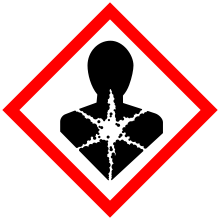
Back سمية تناسلية Arabic Reprotoxicité French Voortplantingstoxiciteit Dutch Üreme toksisitesi Turkish 生殖毒性 Chinese

Reproductive toxicity refers to the potential risk from a given chemical, physical or biologic agent to adversely affect both male and female fertility as well as offspring development.[1] Reproductive toxicants may adversely affect sexual function, ovarian failure, fertility as well as causing developmental toxicity in the offspring.[2][3] Lowered effective fertility related to reproductive toxicity relates to both male and female effects alike and is reflected in decreased sperm counts, semen quality and ovarian failure.
- ^ Occupational Health and Safety Administration. "Reproductive Hazards". osha.gov. Retrieved 6 February 2022.
- ^ "Regulation (EC) No 1272/2008 of the EUROPEAN PARLIAMENT and of the COUNCIL". Official Journal of the European Union. 16 December 2008.
Annex I, section 3.7 labelling and packaging of substances and mixtures, amending and repealing Directives 67/548/EEC and 1999/45/EC, and amending Regulation (EC) No 1907/2006.
- ^ International Programme on Chemical Safety (2001). "Principles For Evaluating Health Risks To Reproduction Associated With Exposure To Chemicals". Environmental Health Criteria. 225. Geneva: World Health Organization.